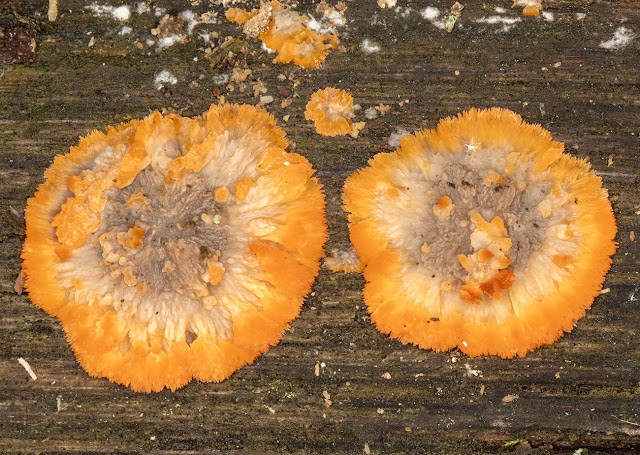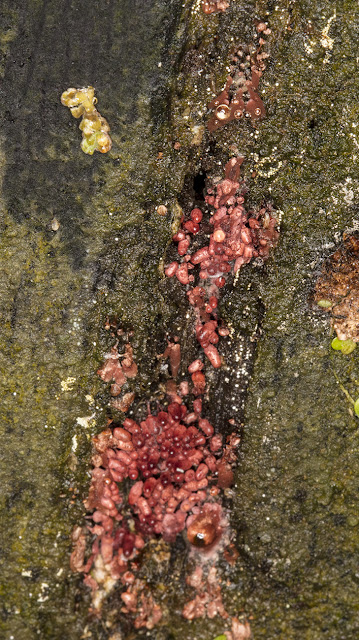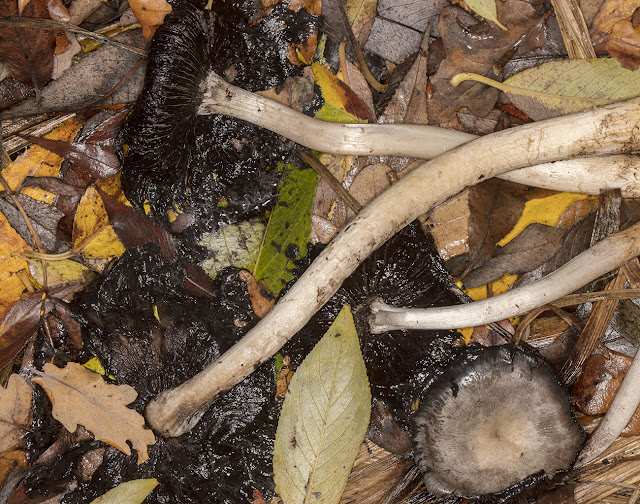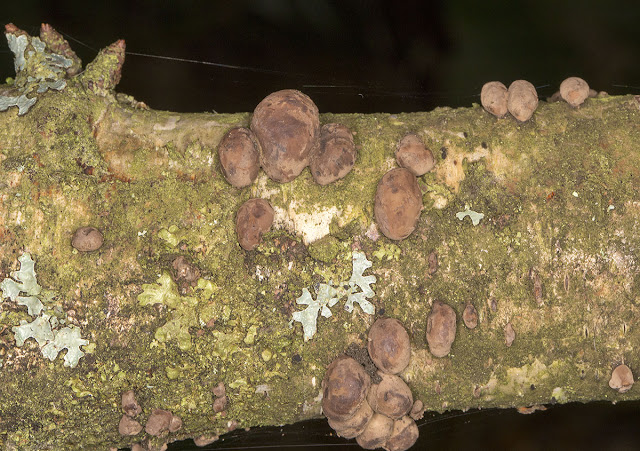 |
| Horse-chestnut trees, Aesculus hippocastanum. The Knoll, Hayes, 12 November 2016. |
Two Horse-chestnut trees in my local park, both severely cut back. Not long ago, we were warned by these signs:
 |
| Notice on Horse-chestnut trees. The Knoll, Hayes, 29 October 2016 |
Well, they have been reduced, though not really to monoliths (which means a standing stone or something that resembles one). But why? Well, look at this.
 |
| Fungi on a Horse-chestnut tree. The Knoll, Hayes, 14 December 2016. |
On the right of this tree you can see a series of bracket fungi, a Ganoderma species, and higher up a cluster of something else. Those Ganodermas are tough, half corky and half woody.
 |
| Ganoderma species on Horse Chestnut, Aesculus hippocastanum. The Knoll, Hayes. 14 December 2016. |
I tried to get a cross-section of one of those brackets. You can sometimes tell the species by looking at the layer between each year's growth. And here, you can see just where my hacksaw blade broke.
At the bottom of the tree there are even bigger brackets:
 |
| Ganoderma species on Horse Chestnut, Aesculus hippocastanum. The Knoll, Hayes. 14 December 2016. |
Almost hidden by fallen leaves. Still the same species. It has penetrated all up and down the tree. You can jump up and down on those tough brackets without budging them.
The upper cluster looks like this:
 |
| Pleurotus ostreatus, Oyster Mushroom, on Horse Chestnut. The Knoll, Hayes, 10 December 2016. |
They are Oyster Mushrooms, a quite different species, an annual growth. You can also see that the tree has a typical woodpecker nest hole and that the dead wood has many beetle holes. It's not common to see more than one fungus species fruiting on a living tree. Here there are three, because:
At the base of the tree on the other side:
 |
| Chondrostereum purpureum, Silverleaf, on Horse Chestnut. The Knoll, Hayes. 14 December 2016. |
Several clumps of a purplish fungus. It's very pretty close up.
 |
| Chondrostereum purpureum, Silverleaf, on Horse Chestnut. The Knoll, Hayes. 14 December 2016. |
It's also very bad for the tree. This is the fungus that causes silverleaf on plum trees. It's a killer, but usually, healthy trees not related to plums can resist it.
So, three rather nasty fungal infections, plus birds and insects. This is a weak tree and it's no wonder it was cut back to stop the wind from blowing it over.
What about the other tree? Well earlier in the year I took this photo:
 |
| Dryad's Saddle, Polyporus squamosus, on Horse-chestnut. The Knoll, Hayes, 4 September 2016. |
Large amounts of yet another fungus, Dryad's Saddle. Here you can also see that the green leaves are turning brown too early. This is because of an infestation by the Horse-chestnut Leaf-miner moth, whose larvae eat out the insides of the leaves of all our local horse-chestnut trees. Although the trees survive, it's thought that this must weaken them, and these two examples support that theory.
Dryad's Saddle is an annual growth, and the big brackets drop to the ground in winter.
 |
| Horse-chestnut Leaf-miner, Cameraria ohridella. On the door above my garden light trap in Hayes on 11 August 2015. |
This is the tiny Horse-chestnut Leaf-miner moth - this specimen came to my garden light trap last year. I have seen clouds of them around horse-chestnut trees in their flight season. The species was first seen in England in 2002 and has spread rapidly through the south-east.
So the trees are supporting an excellent diversity of life, if they will oblige by not falling over!
p.s. Here are three local monolithic trees to show what I expected.
 |
| Three monolithic trees. Hayes Common and West Wickham Common, 24 December 2016. |
The centre tree, a silver birch, has probably reached this state naturally. The beech on the left, and what I think is an oak on the right, are near paths and were probably reduced to remove the chance that they would fall on someone passing by.
Of course it's possible that more work will be done on the horse-chestnuts, even though their signs have gone.

















































